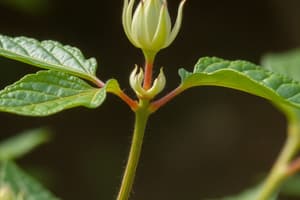Podcast
Questions and Answers
What role does Pto play in relation to the effector AvrPto?
What role does Pto play in relation to the effector AvrPto?
- It competes with FLS2 for AvrPto binding. (correct)
- It blocks the immune response of the plant.
- It triggers disease symptoms in the plant.
- It enhances FLS2's binding affinity.
Which model highlights the interaction involving guarded effector targets?
Which model highlights the interaction involving guarded effector targets?
- Guard model (correct)
- Decoy model
- Quantitative model
- Resistance model
What is considered a promising area in plant disease resistance breeding?
What is considered a promising area in plant disease resistance breeding?
- Helical resistance genes.
- Qualitative resistance genes.
- Transformational gene editing.
- Quantitative disease resistance mechanisms. (correct)
Which effector is known to bind FLS2 and block plant immune responses?
Which effector is known to bind FLS2 and block plant immune responses?
What might be necessary for long-lasting effectiveness in plant resistance breeding?
What might be necessary for long-lasting effectiveness in plant resistance breeding?
Which of the following is NOT a characteristic of quantitative resistance?
Which of the following is NOT a characteristic of quantitative resistance?
What is essential for advancing the understanding of plant-microbe interactions?
What is essential for advancing the understanding of plant-microbe interactions?
What effect does the utilization of quantitative resistance genes (QRLs) imply for crop improvement?
What effect does the utilization of quantitative resistance genes (QRLs) imply for crop improvement?
What is the primary characteristic of NBS-LRR genes in plants?
What is the primary characteristic of NBS-LRR genes in plants?
What is suggested about the recessive resistance gene xa13 in rice?
What is suggested about the recessive resistance gene xa13 in rice?
Which of the following statements about recessive resistance is true?
Which of the following statements about recessive resistance is true?
What role does the pvr2 locus play in pepper plants?
What role does the pvr2 locus play in pepper plants?
Which breeding method can be used to develop disease-resistant plants?
Which breeding method can be used to develop disease-resistant plants?
Which group of NBS-LRR genes is characterized by coiled-coil domains?
Which group of NBS-LRR genes is characterized by coiled-coil domains?
Why is susceptible resistance considered an important area of study?
Why is susceptible resistance considered an important area of study?
What is the hypothesis regarding the functioning of recessive resistance genes?
What is the hypothesis regarding the functioning of recessive resistance genes?
What contributes to the resistance of Arabidopsis to Phytophthora brassicae?
What contributes to the resistance of Arabidopsis to Phytophthora brassicae?
In the context of innate immunity, what action does the bacterial virulence protein xa21 perform?
In the context of innate immunity, what action does the bacterial virulence protein xa21 perform?
Which gene is known to block innate immunity in plants by targeting receptor kinases?
Which gene is known to block innate immunity in plants by targeting receptor kinases?
What is the role of quantitative resistance loci in plant breeding?
What is the role of quantitative resistance loci in plant breeding?
How do salicylic acid induction-deficient mutants in Arabidopsis respond after pathogen inoculation?
How do salicylic acid induction-deficient mutants in Arabidopsis respond after pathogen inoculation?
What is a barrier that pathogens must overcome to successfully infect plants?
What is a barrier that pathogens must overcome to successfully infect plants?
Which mechanism is employed by strains of Pseudomonas syringae to evade plant defenses?
Which mechanism is employed by strains of Pseudomonas syringae to evade plant defenses?
Which plant defense response is primarily associated with pathogen-associated molecular patterns (PAMPs)?
Which plant defense response is primarily associated with pathogen-associated molecular patterns (PAMPs)?
Flashcards
Recessive Disease Resistance
Recessive Disease Resistance
A type of disease resistance in plants where resistance isn't expressed unless both copies of the gene are the resistance type.
R genes
R genes
Genes that control disease resistance in plants, often involved in qualitative resistance.
NBS-LRR genes
NBS-LRR genes
A large class of R genes characterized by nucleotide-binding site (NBS) and leucine-rich repeat (LRR) domains crucial for plant disease resistance.
Qualitative Resistance
Qualitative Resistance
Signup and view all the flashcards
TIR genes
TIR genes
Signup and view all the flashcards
Xa13 gene
Xa13 gene
Signup and view all the flashcards
Susceptibility Allele
Susceptibility Allele
Signup and view all the flashcards
eIF4E gene (pvr2)
eIF4E gene (pvr2)
Signup and view all the flashcards
AvrPto effector
AvrPto effector
Signup and view all the flashcards
FLS2
FLS2
Signup and view all the flashcards
Decoy model
Decoy model
Signup and view all the flashcards
Guard model
Guard model
Signup and view all the flashcards
Quantitative disease resistance (QRL)
Quantitative disease resistance (QRL)
Signup and view all the flashcards
Resistance gene (R gene)
Resistance gene (R gene)
Signup and view all the flashcards
Pto protein
Pto protein
Signup and view all the flashcards
Pathogen effector
Pathogen effector
Signup and view all the flashcards
Arabidopsis Resistance
Arabidopsis Resistance
Signup and view all the flashcards
PAMP-Triggered Immunity (PTI)
PAMP-Triggered Immunity (PTI)
Signup and view all the flashcards
Plant Disease Resistance Genes
Plant Disease Resistance Genes
Signup and view all the flashcards
Bacterial Virulence Protein
Bacterial Virulence Protein
Signup and view all the flashcards
Quantitative Disease Resistance
Quantitative Disease Resistance
Signup and view all the flashcards
Hormone Crosstalk
Hormone Crosstalk
Signup and view all the flashcards
Effector AvrPto
Effector AvrPto
Signup and view all the flashcards
Disease Resistance Locus
Disease Resistance Locus
Signup and view all the flashcards
Study Notes
Plant Resistance to Pathogens
- Plants constantly battle against microbial and other pathogens.
- Pathogens invade plants via leaf and root surfaces or natural openings like stomata.
- Pathogens degrade cell walls, introduce effectors, and disrupt host activities
- Plants have evolved physical and chemical barriers and a two-tiered immune system (PTI and ETI).
Qualitative Disease Resistance
- Qualitative resistance (controlled by a major gene) is effective against specific pathogens.
- Primarily involved in defense against biotrophic pathogens.
- R genes are typically NBS-LRR genes (Nucleotide-binding site and Leucine-rich repeat).
- These genes encode proteins with various domains (TIR, CC, LRR, etc.).
- Major genes can be overcome by new virulent pathogens
- Quantitative disease resistance is more durable.
Quantitative Disease Resistance
- Quantitative resistance (controlled by multiple genes with minor effects) is more durable against a wide range of pathogens.
- Involves multiple genes with minor effects.
- Fewer selection pressures against pathogen variants.
- Includes genes related to morphology, defense signaling, and secondary metabolites.
- Some QRLs are related to flowering time and basal defense.
Mechanisms Underlying Plant Resistance
- Biotrophic Pathogens: Plant defenses are largely due to gene-to-gene resistance leading to hypersensitive response (HR).
- Necrotrophic Pathogens: No clear gene-for-gene relationship, relying on basal defenses.
- Include pathways like salicylic acid (SA), jasmonic acid (JA), and ethylene signaling.
- Phytoalexins (e.g., camalexin) play vital roles.
RNA Silencing in Plant Resistance
- RNA silencing is a primary defense mechanism against viral pathogens.
- Triggers are double-stranded RNA.
- Process involves a Dicer/Dicer-like protein and RISC complex to degrade or silence homologous RNA and genes.
- Viruses might produce proteins that suppress host RNA silencing to facilitate infection.
Two-Tiered Innate Immune System in Plants
- Plants lack mobile defenders and a somatic adaptive immune system.
- Their immune system has two main tiers:
- PTI (PAMP-triggered immunity): activated by pathogen-associated molecular patterns (PAMPs).
- ETI (Effector-triggered immunity): activated by recognizing pathogen effectors.
Elicitor-Suppressor and Elicitor-Receptor Models
- Elicitor-suppressor model: Pathogens use general elicitors that trigger defense responses countered by specific suppressors.
- Elicitor-receptor model: Pathogens proteins or metabolites are recognized and trigger defense by resistance genes.
Guard and Decoy Models
- Guard model: R proteins guard specific host proteins targeted by effectors.
- Decoy model: Host proteins act as decoys to distract effectors and thus help detect and defend against pathogens.
Quantitative Resistance Loci (QRLs) and Major Genes
- QRLs are useful for broad-spectrum resistance.
- Major genes contribute to resistance, but their effectiveness is often short-term.
Studying That Suits You
Use AI to generate personalized quizzes and flashcards to suit your learning preferences.




